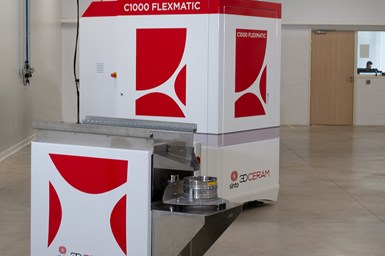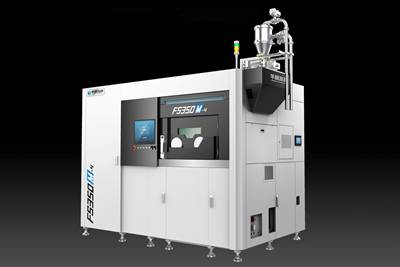3D Printing Helps Push the Boundaries for Green Energy
Partners in the European HyP3D project say they have reached a breakthrough in high-pressure hydrogen production through 3D printing.
Share
Read Next
3DCeram’s C1000 Flexmatic industrial ceramic printer is a part of the HyP3D project’s semiautomatic production line. The Photo Credit: 3dCERAM
Participants in the European HyP3D project say the endeavor has emerged as a trailblazing initiative set to redefine the landscape of hydrogen production. Leveraging 3D printing manufacturing techniques, the project aims to showcase the viability of a disruptive high-pressure Solid Oxide Electrolysis Cell (SOEC) technology, promising efficiency and sustainability.
At the core of the HyP3D project lies the goal of delivering an ultracompact, high-pressure standalone SOEC stack capable of converting electricity into compressed hydrogen. Unlike conventional methods, the HyP3D aims to develop a technology that harnesses the power of 3D printed SOEC cells with a substantial active area of 70 cm², embedded functionalities and the capacity to achieve hydrogen production at remarkably high current densities exceeding 0.90A/cm² (~1.3V) under conditions of 850°C and 5-plus bar pressure.
The group says the manufacturing breakthrough achieved by HyP3D presents a paradigm shift from traditional ceramics SOEC processing. The outcome is the creation of ultrahigh power density SOEC stacks, boasting a power output of 2.14 kW within a compact volume of 630 cm³. It is said this achievement will translate to a threefold increase in specific power per unit volume (3.4 kW/L) and a fourfold rise in specific power per unit mass (1.10 kW/kg), outstripping existing benchmarks.
One of the collaborators in the HyP3D project is H2B2, an organization specializing in all aspects of hydrogen production systems. Armed with expertise in energy efficiency and cost-reduction strategies, H2B2’s involvement aims to elevate the project’s success. The company’s ownership of the manufacturing pilot line streamlines the production of HyP3D cells.
3DCeram is another collaborator whose project’s work plan and methodology entail an intricate optimization process spanning printable feedstock, 3D printing parameters and thermal treatments. By formulating specialized slurries for SLA 3D printing utilizing commercial YSZ powders, the teams are delving into the rheological behavior and printing tests. The innovation extends to designing optimal procedures, culminating in the production of complex-shaped parts mirroring the final cell dimensions.
To successfully carry out this project, 3DCeram will conduct this work using the C1000 Flexmatic, the latest semiautomatic production line. The printer features a 320 × 320 mm build platform that aligns with the project’s industrial ambitions. Moreover, it is said the industrialization possibilities offered by the C1000 Flexmatic are essential for the successful completion of the project.
HyP3D’s vision doesn’t stop at materializing dense, mechanically robust components. Collaborators 3DCeram and IREC are focused on formulating optimal printing strategies, ensuring reliability and maximizing production yield. The project aligns with the broader objectives of advancing the hydrogen economy, reducing time-to-market significantly, slashing raw material consumption by 76% and minimizing the initial investment by 42% compared to conventional manufacturing processes.
With this HyP3D initiative, the energy sector can witness a convergence of 3D printing prowess and hydrogen innovation, propelling the world toward a more sustainable energy future.
- Read about another 3DCeram ceramic printer, this one for development, prototypes. The printer is designed for ease of use, offering plug and play for ceramic 3D printing.
Related Content
8 Cool Parts From Formnext 2024: The Cool Parts Show #78
End-use parts found at Formnext this year address various aspects of additive's advance, notably AM winning on cost against established processes.
Read More3D Printed Titanium Replaces Aluminum for Unmanned Aircraft Wing Splice: The Cool Parts Show #72
Rapid Plasma Deposition produces the near-net-shape preform for a newly designed wing splice for remotely piloted aircraft from General Atomics. The Cool Parts Show visits Norsk Titanium, where this part is made.
Read MoreThis Drone Bird with 3D Printed Parts Mimics a Peregrine Falcon: The Cool Parts Show #66
The Drone Bird Company has developed aircraft that mimic birds of prey to scare off problem birds. The drones feature 3D printed fuselages made by Parts on Demand from ALM materials.
Read MoreDMG MORI: Build Plate “Pucks” Cut Postprocessing Time by 80%
For spinal implants and other small 3D printed parts made through laser powder bed fusion, separate clampable units resting within the build plate provide for easy transfer to a CNC lathe.
Read MoreRead Next
Profilometry-Based Indentation Plastometry (PIP) as an Alternative to Standard Tensile Testing
UK-based Plastometrex offers a benchtop testing device utilizing PIP to quickly and easily analyze the yield strength, tensile strength and uniform elongation of samples and even printed parts. The solution is particularly useful for additive manufacturing.
Read MoreBike Manufacturer Uses Additive Manufacturing to Create Lighter, More Complex, Customized Parts
Titanium bike frame manufacturer Hanglun Technology mixes precision casting with 3D printing to create bikes that offer increased speed and reduced turbulence during long-distance rides, offering a smoother, faster and more efficient cycling experience.
Read MoreCrushable Lattices: The Lightweight Structures That Will Protect an Interplanetary Payload
NASA uses laser powder bed fusion plus chemical etching to create the lattice forms engineered to keep Mars rocks safe during a crash landing on Earth.
Read More





















